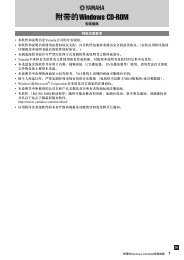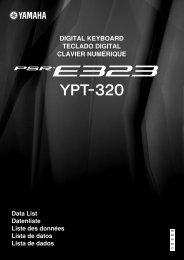You also want an ePaper? Increase the reach of your titles
YUMPU automatically turns print PDFs into web optimized ePapers that Google loves.
Vocal Harmony Parameter List (PSR-S950) / Liste der Vokalharmonie-Parameter (PSR-S950) / Liste des paramètres liés à l’harmonie vocale (PSR-S950) / Lista de parámetros de<br />
64<br />
Chordal Type List<br />
Type Name Description<br />
2Abv&1Blw.Simple Harmony based on 3-tone chord, 2 above and 1 below; suitable for backing chorus parts. Basically it generates harmonies within an octave.<br />
1Abv&2Blw.Simple Harmony based on 3-tone chord, 1 above and 2 below; suitable for backing chorus parts. Basically it generates harmonies within an octave.<br />
1Abv&2Blw.Open<br />
Harmony based on 3 total tones from chords and scales, 1 above and 2 below; it can produce a feeling of movement. Basically it generates open<br />
harmonies of an octave or more.<br />
1Abv&2Blw.OpenPara<br />
Harmony based on 3 total tones from chords and scales, 1 above and 2 below; it can produce a feeling of movement. Basically it generates open<br />
harmonies of an octave or more. It includes the effect of creating parallel motion of a half tone in certain conditions.<br />
Harmony based on 3 total tones from chords and scales, 1 above and 2 below; it can produce a feeling of movement. Basically it generates open<br />
1Abv&2Blw.OpenBlues<br />
harmonies of an octave or more. Since it adds a major second as a scale tone to harmony during 7th chords, it provides a passing tone during 7th<br />
chords—suitable for 3-tone chord blues or for country rock in major keys. There are cases where it is not suitable during 7th chord in minor keys.<br />
1Abv&1Blw+UnsD.Simple Harmony suitable for a trio based on 2-tone chord, 1 above and 1 below (+ Oct. below the input pitch); it is suitable for backing chorus parts.<br />
3Blw.Closed<br />
Harmony based on 3 total tones from chords and scales, 3 below; it can produce a feeling of movement. Basically it generates harmonies within an octave.<br />
It is unsuitable for low input pitch, because the harmonies are low.<br />
3Blw.ClosedPara<br />
Harmony based on 3 total tones from chords and scales, 3 below; it can produce a feeling of movement. Basically it generates harmonies within an octave.<br />
It is unsuitable for low input pitch, because the harmonies are low. It includes the effect of creating parallel motion of a half tone in certain conditions.<br />
Harmony based on 3 total tones from chords and scales, 3 below; it can produce a feeling of movement. Basically it generates harmonies within an octave.<br />
3Blw.ClosedBlues<br />
It is unsuitable for low input pitch, because the harmonies are low. Because it adds the major second as the scale tone to harmony during 7th chord, it<br />
provides a passing tone during 7th chords—suitable for 3-tone chord blues in major keys or for country rock. There are cases where it is not suitable during<br />
7th chord in minor keys.<br />
2Blw+Bass.Chordal Harmony based on 3-tone chord, 2 below and a chord root; it is suited for backing chorus parts.<br />
2Blw+UnsD.Modal Harmony suitable for a trio based on 2 total tones from chords and scales, 2 below (+ Oct. below the input pitch); it can produce a feeling of movement.<br />
Harmony suitable for a trio based on 2 total tones from chords and scales, 2 below (+ Oct. below the input pitch); it can produce a feeling of movement.<br />
2Blw+UnsD.ModalBlues Because it adds a major second as a scale tone to harmony during 7th chords, it provides a passing tone during 7th chords—suitable for 3-tone chord<br />
blues or for country rock in major keys. There are cases where it is not suitable during 7th chord in minor keys.<br />
1Blw+UnsD+Bass<br />
Harmony suitable for a duet based on 1 total tone from chord and scale, the nearby 1 below (+ Oct. below the input pitch and chord root); it can produce a<br />
feeling of movement.<br />
1Blw.Far+UnsD+Bass<br />
Harmony suitable for a duet based on 1-tone chord, 1 below, (priority on character) (+ Oct. below the input pitch and chord root). This setting skillfully<br />
expresses the chord character.<br />
3Abv.Jazz<br />
Harmony based on 3 total tones from chords and scales, 3 above; it can produce a feeling of movement. Basically it generates harmonies within an octave.<br />
It is suitable for low pitched vocals.<br />
3Abv.Chordal Harmony based on 3-tone chord, 3 above; it is suitable for backing chorus parts. It is also good for low pitched vocals.<br />
Harmony based on 3 total tones from chords and scales, 3 above; it handles a major triad as add 6th chord. Because it handles the major second as a<br />
3Abv.JazzPara<br />
scale tone in major triads, it can also provide passing tones. Basically it generates harmonies within an octave. It includes the effect of creating parallel<br />
motion of a half tone in certain conditions. It is suitable for low pitched vocals.<br />
Harmony based on 3 total tones from chords and scales, 3 above; it handles a major triad as add 6th chord. Since it handles the major second as a scale<br />
tone in major triads, it can also provide passing tones. Because it adds a major second as a scale tone to harmony during 7th chords, it provides a passing<br />
3Abv.JazzBluesPara<br />
tone during 7th chords—suitable for 3-tone chord blues or for country rock in major keys. Basically it generates harmonies within an octave. It includes the<br />
effect of creating parallel motion of a half tone in certain conditions. There are cases where it is not suitable during 7th chord in minor keys. It is suitable for<br />
low pitched vocals.<br />
2Abv&1Blw.WideH<br />
Harmony based on 3 total tones from chords and scales, 2 above and 1 below; it can produce a feeling of movement. Basically it generates open<br />
harmonies of an octave or more. It is suitable for low pitched vocals.<br />
Harmony based on 3 total tones from chords and scales, 2 above and 1 below; it can produce a feeling of movement. Because it combines elements<br />
2Abv&1Blw.forDuo<br />
suited for duets, HARM. 1, 2 and 3 can be independently selected for use for duets. It can also be used for octave transposing. Basically, the highest tone<br />
(HARM.1) is an octave above the lowest tone (HARM.3), and this tone (HARM.1 or HARM.3) handles the major second as the scale tone in major triads.<br />
(You should be careful, however, depending on the song.) It is suited for low pitched vocals in situations where all harmonies are used for a quartet.<br />
Harmony based on 3 total tones from chords and scales, 2 above and 1 below; it handles a major triad as add 6th chord. Because it handles the major<br />
2Abv&1Blw.Jazz<br />
second as a scale tone in major triads, it can also provide passing tones. Basically, the highest tone (HARM.1) is an octave above the lowest tone<br />
(HARM.3). Each of its tones is treated as an element, so it can be used for duets or trios. It is suitable for low pitched vocals.<br />
2Abv&1Blw.WideL<br />
Harmony based on 3 total tones from chords and scales, 2 above and 1 below; it can produce a feeling of movement. Its harmony range tends to be lower<br />
than that of Wide H. Basically it generates open harmonies of an octave or more. It is suitable for low pitched vocals.<br />
2Abv+UnsD.Modal6th<br />
Harmony suitable for a trio based on 2 total tones from chords and scales, 2 above (+ Oct. below the input pitch); it handles a major triad as add 6th chord.<br />
Because it handles the major second as a scale tone in major triads, it can also provide passing tones. It is suitable for low pitched vocals.<br />
2Abv+Bass.Modal6th<br />
Harmony suitable for a trio based on 2 total tones from chords and scales, 2 above (+ chord root); it handles a major triad as add 6th chord. Because it<br />
handles the major second as a scale tone in major triads, it can also provide passing tones. It is suitable for low pitched vocals.<br />
UnsU+1Abv+Bass.Open<br />
Harmony suitable for a duet based on 1 total tone from chord and scale, the nearby 1 above (+ Oct. below the input pitch and chord root); it can produce<br />
a feeling of movement.<br />
1Abv&2Blw.Jazz<br />
Harmony based on 3 total tones from chords and scales, 1 above and 2 below; it can produce a feeling of movement. Because it handles the major second<br />
as a scale tone in major triads, it can also provide passing tones. Basically it is a closed harmony within an octave.<br />
Harmony based on 3 total tones from chords and scales, 1 above and 2 below; it can produce a feeling of movement. Because it handles the major second<br />
1Abv&2Blw.80s<br />
as a scale tone in major triads, it can also provide passing tone. With priority on the chord’s character, it is good for broadening the sound in which Maj7<br />
and m7 chords are often used. Basically it generates closed harmonies within an octave.<br />
Harmony based on 3 total tones from chords and scales, 1 above and 2 below; it can produce a feeling of movement. Since it handles the major second as<br />
1Abv&2Blw.Blues<br />
a scale tone in major triads, it can also provide passing tones. Because it adds the major second as a scale tone to harmony during 7th chords, it provides<br />
a passing tone during 7th chords—suitable for 3-tone chord blues in major keys or for country rock. Basically it generates closed harmonies within an<br />
octave.<br />
Harmony based on 3 total tones from chords and scales, 1 above and 2 below; it can produce a feeling of movement. Because it handles the major second<br />
1Abv&2Blw.ChordalBlues<br />
as a scale tone in major triads, it can also provide passing tones. Because it adds the major second as a scale tone to harmony during 7th chords, it<br />
provides a passing tone during 7th chords—suitable for 3-tone chord blues in major keys or for country rock. With priority on the chord’s character, it is<br />
good for broadening the sound in which Maj7 and m7 chords are often used. Basically it generates closed harmonies within an octave.<br />
Harmony based on tone chords and scale tones used as duet, 1 above and 2 below; it can produce a feeling of movement. HARM.1 is a tone above and<br />
1Abv&2Blw.Chordal<br />
nearest the input pitch. HARM.2, tone which is below the input pitch and nearest the input pitch, handles a major triad as add 6th chord. HARM.3 is<br />
harmony with priority on the chord character of the lower notes. Because it handles the major second as a scale tone in major triads, it can also provide<br />
passing tones.<br />
1Abv&2Blw.Wide<br />
Harmony based on 3 total tones from chords and scales, 1 above and 2 below; it can produce a feeling of movement. It handles a major triad as add 6th<br />
chord. Since it handles the major second as a scale tone, it can also provide passing tones. Basically it generates open harmonies of an octave or more.<br />
Harmony based on 3 total tones from chords and scales, 1 above and 2 below; it can produce a feeling of movement. Since it handles a major triad as add<br />
1Abv&2Blw.WideBlues<br />
6th chord, and handles the major second as a scale tone, it can also provide passing tones. Because it adds the major second as a scale tone to harmony<br />
during 7th chords, it provides a passing tone during 7th chords—suitable for 3-tone chord in major keys or for country rock. Basically it generates open<br />
harmonies of an octave or more.<br />
Harmony based on tone chords and scale tones used as duet, 1 above and 1 below; (+ chord root); it can produce a feeling of movement. HARM.1 is a<br />
1Abv&1Blw+Bass<br />
tone above and nearest the input pitch. HARM.2, tone which is below the input pitch and nearest the input pitch, handles a major triad as add 6th chord,<br />
and since it handles the major second as a scale tone in major triads, it can provide passing tones.<br />
1Abv&1Blw+UnsD.Modal6th<br />
Harmony suitable for a trio based on 2 total tones from chords and scales, a above and below (+ Oct. below the input pitch); it can produce a feeling of<br />
movement. Because it handles a major triad as add 6th chord, and handles the major second as a scale tone, it can provide passing tones.<br />
Harmony based on tone chords and scale tones used as duet, 1 above and 1 below (+ chord root); it can produce a feeling of movement. HARM.1 is<br />
1Abv&1Blw+Bass.Modal6th<br />
harmony of above tone with priority on the chord character. HARM.2, harmony near the below side, handles a major triad as add 6th chord, and since it<br />
handles the major second as a scale tone, it can provide passing tones. Because it handles the major second as a scale tone in major triads, it can also<br />
provide passing tones.<br />
3Blw.Jazz<br />
Harmony based on 3 total tones from chords and scales, 3 below; it handles a major triad as add 6th chord. Because it handles the major second as a<br />
scale tone in major triads, it can also provide passing tones. Basically it generates harmonies within an octave. It is suitable for high pitched vocals.<br />
Harmony based on 3 total tones from chords and scales, 3 below; it handles a major triad as add 6th chord. Because it handles the major second as a<br />
3Blw.JazzBlues<br />
scale tone in major triads, it can also provide passing tones. Because it adds the major second as a scale tone to harmony during 7th chords, it provides a<br />
passing tone during 7th chords—suitable for 3-tone chord blues or for country rock in major keys. Basically it generates harmonies within an octave. It is<br />
suitable for high pitched vocals.<br />
Harmony suitable for a trio based on 2 total tones from chords and scales, 2 below (+ Oct. below input pitch); it handles a major triad as add 6th chord.<br />
2Blw+UnsD.Modal6th<br />
Because it handles the major second as a scale tone in major triads, it can also provide passing tones. Basically it generates harmonies within an octave.<br />
It is suitable for high pitched vocals.<br />
Harmony suitable for a trio based on 2 total tones from chords and scales, 2 below (+ chord root); it handles a major triad as add 6th chord. Because it<br />
2Blw+Bass.Modal6th<br />
handles the major second as a scale tone in major triads, it can also provide passing tones. Basically it generates harmonies within an octave. It is suitable<br />
for high pitched vocals.<br />
This generates harmonies based on the scale specified by the KEY ROOT/TYPE value and the degree specified by the DEGREE value. The harmonies are<br />
ScaleDiatonic<br />
not dependent on a chord. If there are many notes, the chord feeling intensifies, so it is suitable for use as duets, fixed at a third above. This setting is good<br />
for modal church music or modal jazz.<br />
Parallel<br />
This can reproduce harmonies for which semitone pitches are fixed 4th build or diminished sounds, for example. This setting is good, for example, in modal<br />
jazz scales (when you want to eliminate chordal feeling) or in progressive music.<br />
PSR-S950/S750 Data List


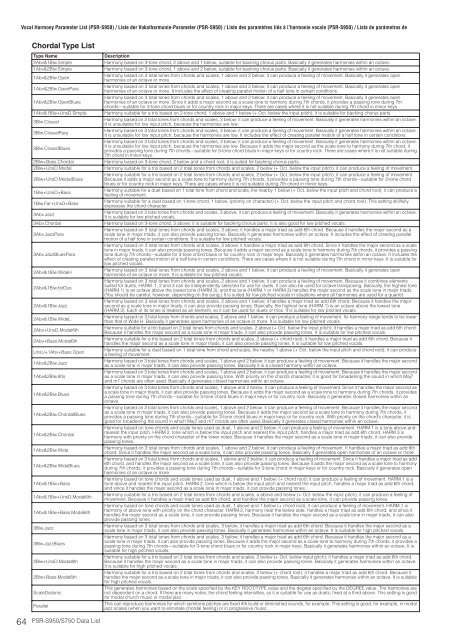

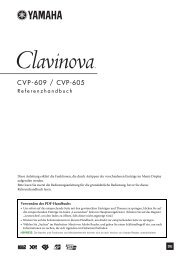

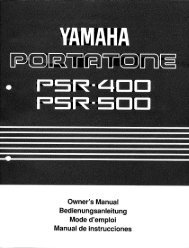

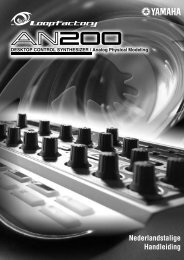
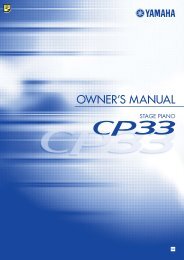



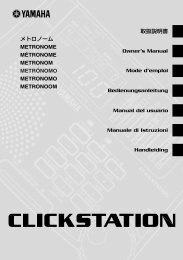

![Premere il pulsante [SONG] - Yamaha](https://img.yumpu.com/50419553/1/184x260/premere-il-pulsante-song-yamaha.jpg?quality=85)
